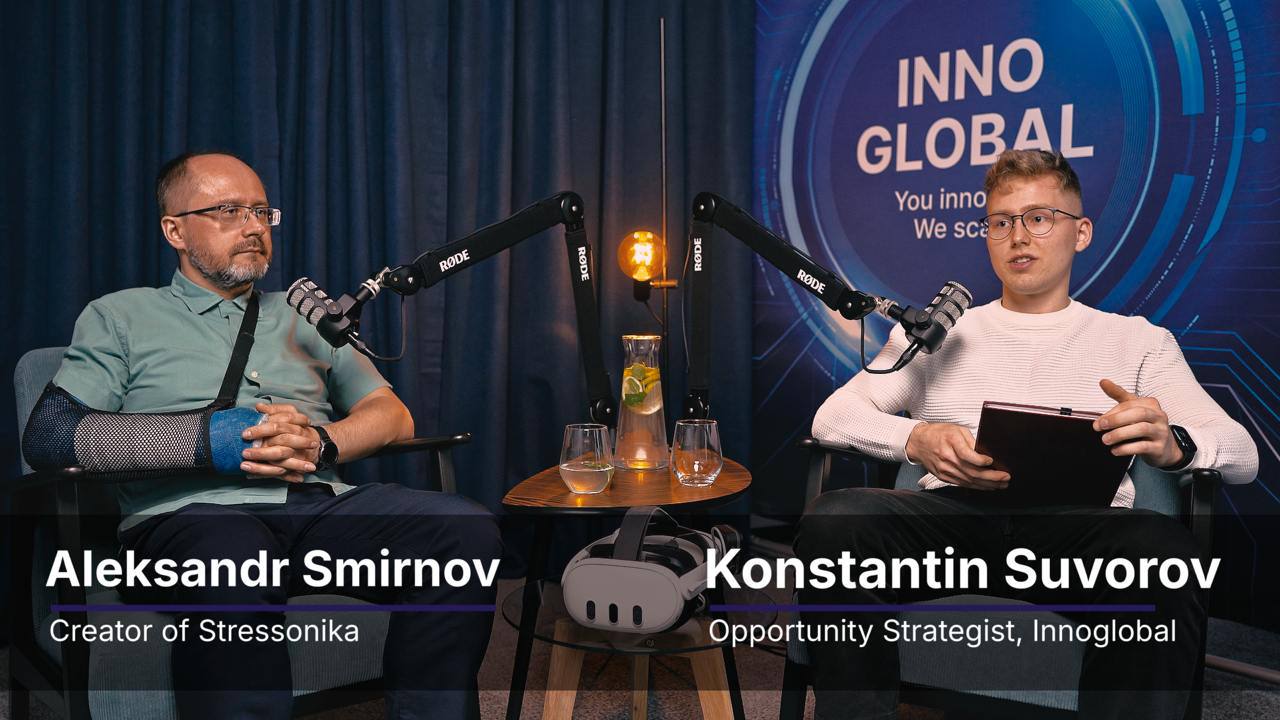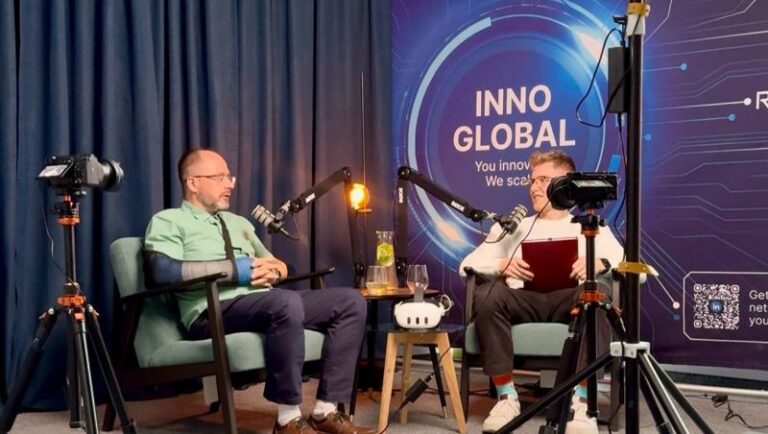Stress: Fuel for Success or Silent Enemy? Insights from the Scale in Poland Podcast
In another captivating episode of the Scale in Poland podcast, we meet Dr. Alexander Smirnov—the creator of Stressonika, an innovative tool revolutionizing stress management and transforming our approach to mental and physical health. Smirnov, a renowned expert in stress physiology, shares his profound insights on how stress can be both a driving force and a silent threat to our well-being. From eustress that propels us into action to distress that risks burnout, Smirnov takes us on a compelling journey through the human body and mind, demonstrating how technology like Stressonika can help us better understand and control our stress responses.
Stress: Two Sides of the Same Coin
Dr. Smirnov begins by defining stress as a non-specific reaction of the body to stressors—whether physical, like hunger; psychological, like work pressure; or behavioral, like conflicts with loved ones. We’re all familiar with the symptoms of stress: dry mouth, racing heartbeat, sweaty palms, tense muscles, and even changes in voice. Psychologically, it manifests as anxiety or excitement, while behaviorally, it shows through nervous movements or faster speech. But stress isn’t always the enemy. Smirnov highlights the existence of eustress—positive stress that motivates and inspires us. “Stress is good when we can control it and when it’s acute, not chronic,” the expert explains, noting that eustress drives us to learn, work, and grow personally. In contrast, distress—the negative form of stress—is linked to a lack of control and chronic strain, potentially leading to serious health consequences.
Chronic Stress: A Silent Killer
Smirnov doesn’t mince words when describing the effects of prolonged stress. When the body remains in a “fight or flight” mode day after day, it results in a constant release of glucose, a halt in regenerative processes, and a hormonal storm—primarily driven by elevated cortisol levels. “When we live with chronic stress, cortisol remains consistently high. This halts many bodily processes, leads to adrenal exhaustion, weight issues, and even increases the risk of autoimmune diseases, cardiovascular problems, or loss of libido,” Smirnov warns. His words serve as a wake-up call for modern individuals who often juggle multiple stressors simultaneously: work, finances, and relationships.
Allostasis: Finding Balance Amid Chaos
Smirnov introduces a fascinating concept called allostasis—the process of maintaining the body’s balance in response to stressors. “Imagine a pharmacy scale with two pans. On one, we place a stressor, which disrupts the balance. On the other, we must add something to restore equilibrium—bodily regulation,” he explains. Small stressors require minor adaptive responses, but when stressors multiply (work, finances, conflicts), the body mobilizes various resources: time management, relaxation, physical activity, or even medication. Overloading this system, however, leads to burnout—a state Smirnov strongly advises avoiding at all costs.
How to Master Stress: Practical Strategies
Smirnov emphasizes that the key to managing stress lies in understanding its root causes. “We need to analyze what’s real stress and what’s self-imposed stress—stemming from our thoughts, expectations, and fears,” he says. He offers several effective techniques:
- Emotional Regulation: Relaxation techniques like resonance breathing (longer exhales than inhales), mindfulness—being fully present in the moment—and body scanning help calm emotions. Smirnov also suggests viewing situations from a third-person perspective or recalling past successful experiences.
- Tackling Real Stress: Developing skills such as communication, time management, or financial planning can enhance a sense of control.
- Cognitive Restructuring: This technique involves transforming negative thoughts into more realistic and positive ones. “I’m scared of this meeting, but I’ll gain new experiences, meet new people, and make connections. I’ll come out of this situation as a winner,” Smirnov exemplifies, illustrating how to shift perspective.
- Socratic Dialogue: Talking to oneself as if advising a friend allows for a more detached view of the problem.
- Physical Techniques: Massage, sound therapy, or exercise can effectively reduce emotional tension.
In situations with no way out, such as the loss of a loved one, Smirnov underscores the importance of support from loved ones. He cites the Harvard Grant Study, which demonstrates that strong, warm relationships are crucial for coping with stress and achieving happiness. “The most important thing is love—from family, partners, friends, even pets. Love is the force that helps us survive and manage most stressors,” he asserts with conviction.
Technology to the Rescue: Stressonika
One of the most intriguing segments of the podcast is Smirnov’s discussion of Stressonika—an innovative software he developed to help people better understand and manage stress. Stressonika leverages virtual reality (VR) technology—using Meta VR headsets and a specialized mask with EEG and ECG sensors—to measure physiological responses, such as brain activity and heart rate, to controlled stressors in a VR environment. “When I saw my results, I was shocked. I was stressed the entire time, even when I tried to relax,” Smirnov recalls, highlighting how the technology helped him gain insight into his own reactions. Stressonika assesses stress levels, cardiovascular health, concentration, and even potential emotions, making it a valuable tool for diagnosing burnout risk and personalizing stress management strategies.
Personalized Approach: Sprinters vs. Marathoners
Smirnov points out the differences in physiological temperament. Some individuals, dubbed “sprinters,” excel at short, intense tasks, while “marathoners” thrive in long, monotonous activities. Stressonika helps identify one’s working style and tailor strategies to avoid overload. “Sometimes, even simple cognitive tasks can cause a high pulse in highly motivated people. Prolonged functioning in this mode without recovery leads to exhaustion,” the expert cautions.
Breathing: A Natural Remedy for Stress
One of the simplest yet most effective tools for combating stress is breathing. Smirnov stresses that conscious breathing techniques, such as resonance breathing, can significantly impact the cardiovascular system and lower stress levels. “Breathing is the only natural mechanism for coping with stress that nature has given us,” he says, encouraging experimentation with breathing patterns and using technology like Stressonika to find the optimal rhythm.
Motivation: Friend or Foe?
An intriguing topic Smirnov explores is the connection between motivation and stress. He notes that motivation often activates the sympathetic nervous system—the same system responsible for the stress response. Consequently, excessive motivation can lead to a state of “hyper-motivation,” which, over time, heightens the risk of burnout. This serves as a crucial reminder that even positive emotions, if unchecked, can have negative repercussions.
Stress as a Catalyst for Action
The Scale in Poland podcast episode featuring Dr. Alexander Smirnov, the creator of Stressonika, offers an inspiring lesson: stress doesn’t have to be an enemy. Eustress can be a powerful fuel for action, provided we learn to manage it effectively. The key lies in understanding our reactions, fostering strong relationships, applying relaxation techniques, and, when needed, leveraging technology like Stressonika. As Smirnov concludes, “We can’t live without stress. We should live with it together.” This is an invitation to approach stress consciously—not as a threat, but as a force that can propel us forward if we learn to harness it wisely.
Watch full “stress” episode:
or listen this episode on spotify:



